Rough, mystical, wildly romantic: The most beautiful places to visit at the Swabian Alps are a true El Dorado for nature lovers, hikers and explorers. Mystical caves, wild valleys, impressive castles and bizarre view rocks full of wildly romantic beauty are perfect for a day trip or a short holiday.
Where is it most beautiful in the Swabian Alps? As a child, I would have immediately shouted with shining eyes: where you can knock fossils, learn more about the first humans, find rose quartz and explore mystical caves with a headlamp with a beating heart, oh and of course the dungeons at Hohenzollern Castle! Today, these 10 places to visit at the Swabian Alps would be my favourites, precisely because they are so different and show the true beauty of this still quite unknown region. After all, who in Germany, apart from the locals, knows the Swabian Alps?
The Swabian Alps are a low mountain range in southern Germany. It stretches about 200 km long and 40 km wide between Tübingen and Aalen to Ulm and the Alb-Donau district. The natural landscape is a UNESCO biosphere reserve and ranges from rock seas, lush flowering meadows, strange juniper heaths and wild valleys to the many deep karst caves. The Swabian Alps is particularly famous for these caves, because the first humans once settled in them and left us tools and musical instruments. Six Alp caves are now UNESCO World Heritage Sites.
And there is even a second UNESCO World Heritage Site to marvel at in the Swabian Alps: the Limes, the old Roman border wall, runs directly through the Swabian Alps. Evidence of the Romans can be found in Aalen, for example. From the Middle Ages onwards, rulers built castles and palaces at the most beautiful vantage points and locations. Some of them are among the most impressive and beautiful castles in Germany and among the excursion destinations in the Swabian Alps that you must see in your lifetime. Compared to the Black Forest, the Swabian Alps is not very well known internationally for tourism, one could almost say it is still an insider tip and a true paradise for all those who want to escape the hustle and bustle of everyday life.
My favourite places are a colourful mix of very different places to visit at the Swabian Alps and are ideal for a romantic short trip, an exciting family outing or a day trip to enjoy nature. On Greatime you can find even more tips for magical excursions in Baden-Württemberg, for example the 10 most beautiful places to visit in the black forest!
The 10 Most Beautiful Places to Visit at the Swabian Alps
Layer by layer through history with hammer and chisel: the Swabian Alps was once largely covered by the Jurassic Sea. At some tapping sites you can even find bones of ichthyosaurs and fossils of ammonites and fish to take home. A great leap forward in history, to the Ice Age, is the cave (and for those who want more, a museum afterwards). Witnesses to recent history, whose visit is a must once in a lifetime, are two of Germany’s most beautiful castles.
Do you know the Blautopf? Who would think that one of the most beautiful places in Germany is hidden behind it? Some of the most beautiful excursion destinations in the Swabian Alps showcase the varied natural landscape and can be wonderfully explored while hiking or cycling.
1. Lichtenstein Castle – the Fairytale Castle of the Swabian Alps
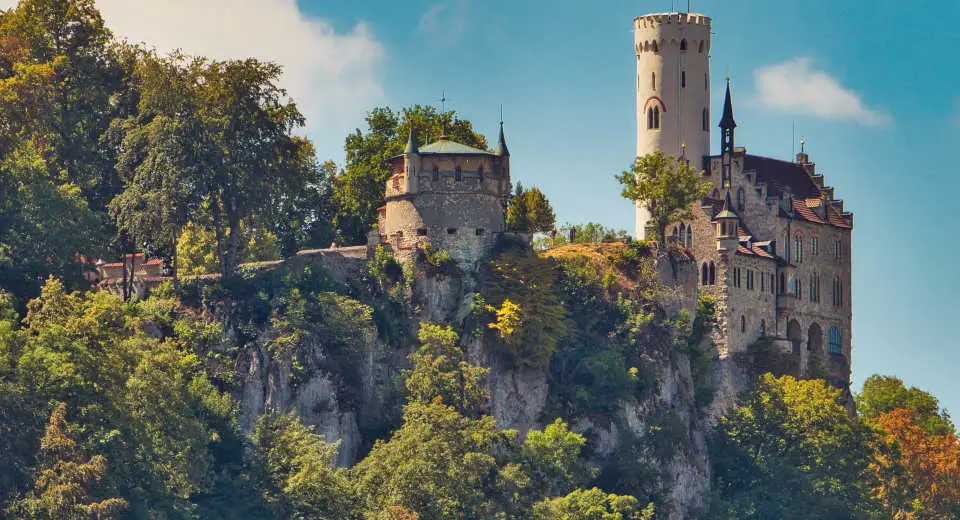
Bavaria has Neuschwanstein Castle, Württemberg has Lichtenstein Castle! Quite different from the famous Bavarian fairytale castle Lichtenstein Castle is still an insider tip and not overrun with tourists. The castle, built in the 19th century, rises in a great location at 817 metres on the Alb ridge and offers a sensational view over the Swabian Alps. Inspired by the novel “Lichtenstein” by Wilhelm Hauf, the ducal family of Urach built this neo-Gothic castle on the medieval foundations of the castle. It is still in the family’s possession today.
The castle can be visited on a 30-minute guided tour. Especially worth seeing is the armoury with its medieval armour and weapons, the richly painted king’s room and the beautiful knights’ hall.
Incidentally, there are also great hiking trails around the castle.
2. Urach Waterfall – The Most Beautiful Waterfall at the Swabian Alps
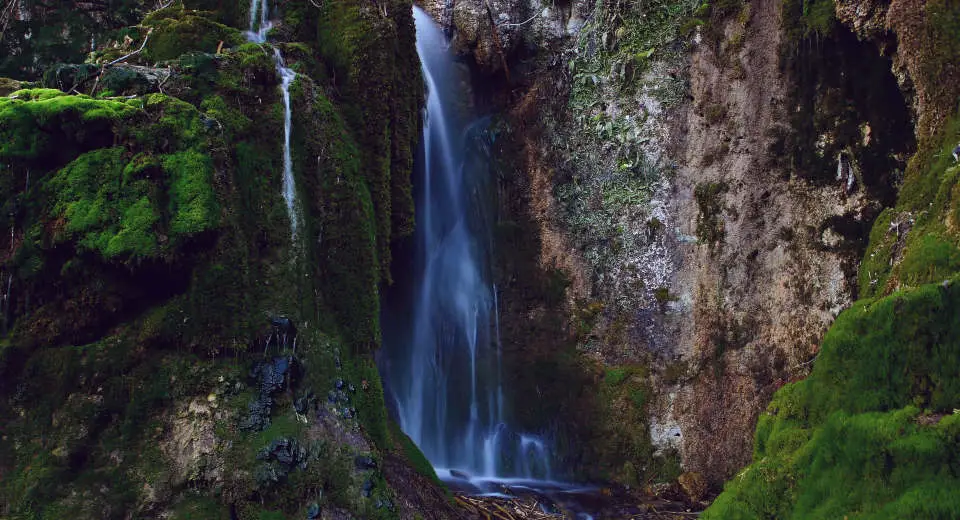
The Urach Waterfall is located in the Maize Valley near Bad Urach. Its waters flow down from a depth of 37 metres. It is particularly impressive when the snow melts and after heavy rainfall. It is the most beautiful waterfall on the Swabian Falls and even the path through the damp, mossy, deep green forest to the waterfall is magical in autumn or spring. The Urach waterfall is particularly beautiful in winter, when the water freezes into ice.
From the hikers’ car park on the B28, you can reach the foot of the waterfall in about 30 minutes and climb up to the middle – it’s worth it!
3. Zeller Horn – Fascinating Panoramic View of the Schwabian Alps Foothills
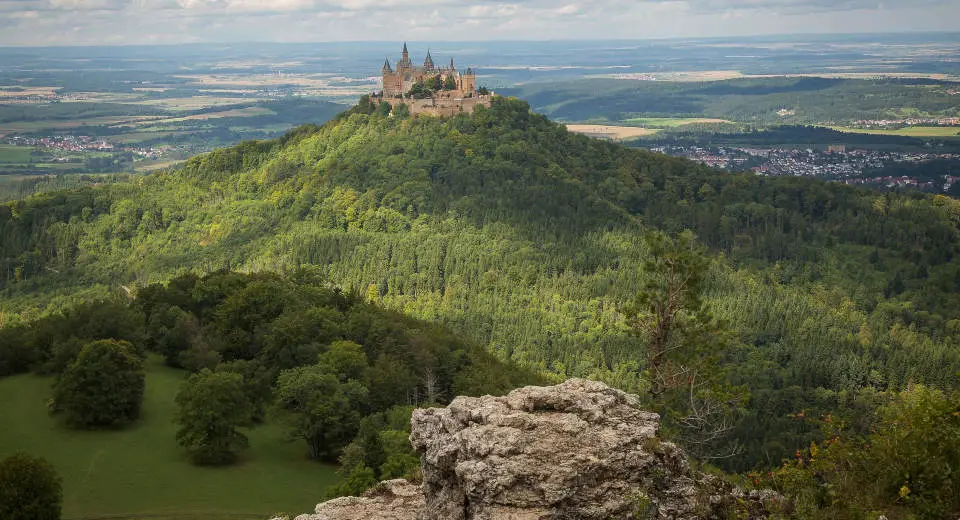
From the Zeller Horn you have one of the most beautiful views over the foothills of the Swabian Alps with the imposing Hohenzollern Castle towering above.
If you like to hike, the best thing to do is to set out on the high-altitude hike along the Alb ridge. It starts at the Stich car park. On this hike, you will pass several vantage points, sometimes with better and sometimes with worse views of Hohenzollern. Taking a narrow, root-covered path, you reach the Zeller Horn with its breathtaking view.
For a shorter hike (1.5 hours), the circular hike starting at the car park at Hotel Zollersteighof is a good choice. It leads to the Zeller Horn and back to the starting point along the Hangenden Stein with its rock crevices popularly known as Höllenlöcher (hell holes).
4. Hohenzollern Castle – Royal Place to Visit at the Swabian Alps
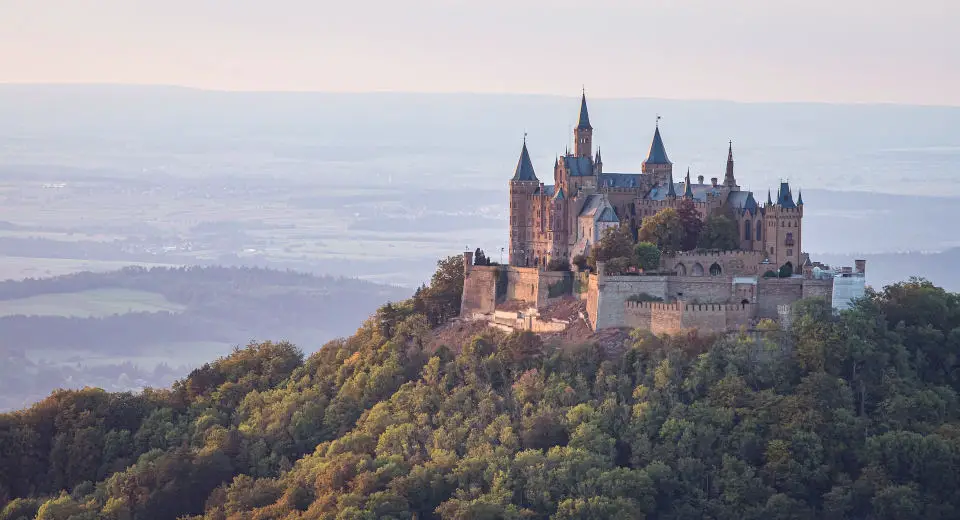
“The view from Hohenzollern Castle is truly worth the trip.”
Kaiser Wilhelm II knew what he was talking about! The pompous Hohenzollern Castle is a summit castle and is located at 855 metres on the Hohenzollern mountain in the municipality of Bisingen. It is still the ancestral castle of the German princely dynasty that produced Prussian kings and emperors and is privately owned by the Hohenzollern family. Proud and mighty it rises on the mountain top and one might think it was a genuine witness from the Middle Ages. In fact, it is a neo-Gothic building.
Presumably in the 11th century, the first castle stood here, which was conquered and almost completely destroyed in the 15th century. The second castle was fought over in the following centuries, was conquered by the Württembergers in the 30 Years’ War and recaptured by a ruse in the 17th century and was first in Habsburg possession and then occupied by French troops in the War of the Austrian Succession (1744/45). The castle then fell into disrepair and was a ruin by the beginning of the 19th century.
In the 19th century, King Frederick IV returned to his roots and the reconstruction of today’s 3rd castle began. It impressively demonstrates the Prussian rulers’ desire for political representation and embodies the romantic spirit of the time with its ideal image of a medieval knight’s castle.
The splendidly furnished interiors of Hohenzollern Castle can be visited on a guided tour. The undisputed highlight is the treasure chamber, where you can see not only valuable silverware and porcelain but also Frederick the Great’s tobacco box, his uniform with the bullet hole and the Prussian royal crown.
The highlight is the treasure chamber, where valuable art-historical objects can be discovered, including the precious silverware and porcelain, the tobacco boxes of Frederick the Great, his uniform coat with the legendary bullet hole, the magnificent court dress of Queen Luise of Prussia as well as the Prussian royal crown.
Admission: Adults: 22 euros | Pupils / Students: 12 euros | Children (from 12 years): 10 euros | Family ticket: 45 euros
5. Tapping Sites for Fossils at the Swabian Alps
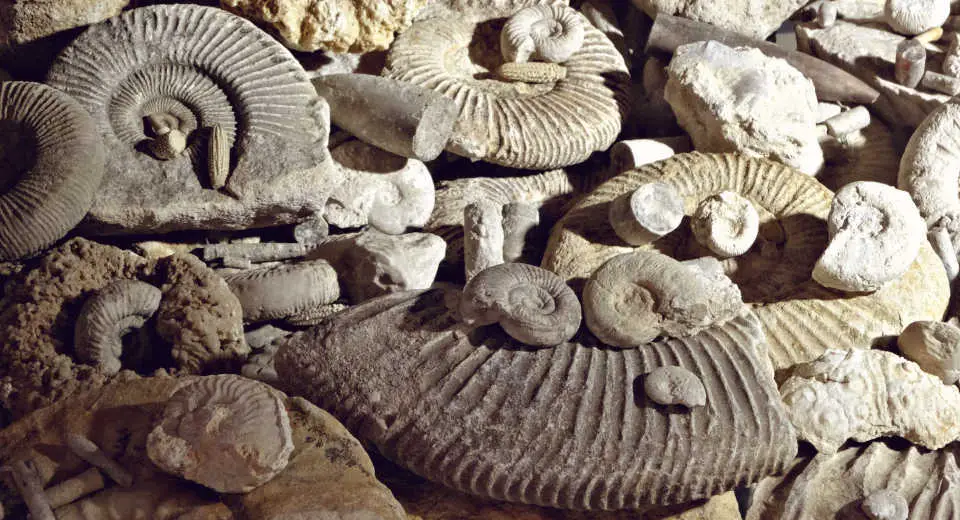
Once upon a time, the Jurassic Sea was where the Swabian Alps is today. It consists of maritime deposits of marl, clay and limestone. In the Jurassic period 200 – 150 million years ago, these rocks were formed at the bottom of a sea that covered large parts of Europe. Today, three main formations of these rocks are distinguished locally by their colour: Lias (black Jurassic), Dogger (brown Jurassic) and Malm (white Jurassic).
Fossils are in all Jurassic sediments and you can easily find them yourself on a hike! Some fossils can be found everywhere in the Swabian Alps, but some are finds from a specific region. The fossils on the Nusplingen Plate in the south-western part of the Swabian Alps are particularly beautiful: sea angels, giant dragonflies and sea crocodiles can be found there in the White Malm.
The most fun fossil hunting is at a tapping site. Some still have a museum where you can marvel at some of the most beautiful finds. Iwent knocking twice as a child and I still get shining eyes today and like to come back. 🙂
Important: For tapping, you have to bring your own tools for most fossil tapping sites and cannot borrow anything on site!
Tapping Sites
- Kromer Slate Quarry in Ohmden
- Slate Experience Park in Dormettingen with tapping site and adventure playground
- Fossil Museum Dotternhausen with tapping site
- Tapping site on the Westerberg near Nusplingen
6. Klosterfelsenweg: Hiking Destinations at the Swabian Alps
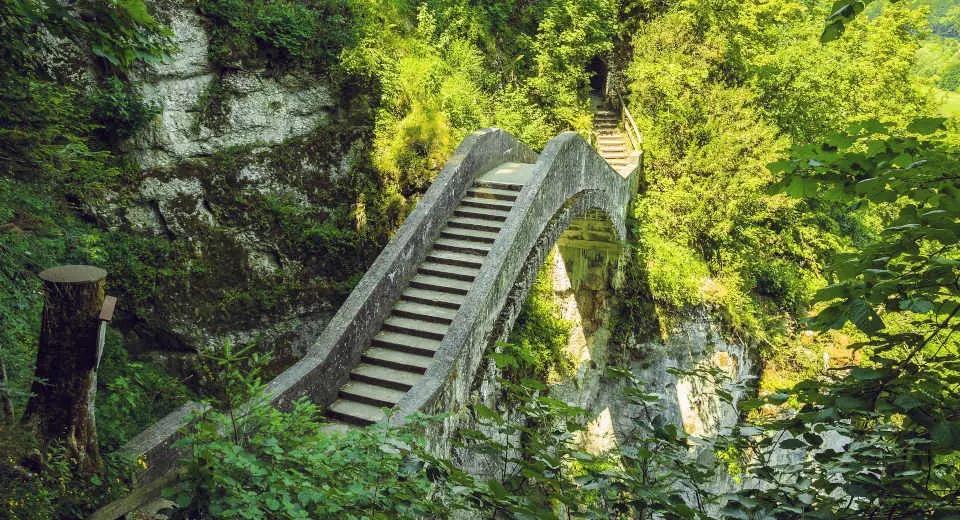
Wonderful bridge, grandiose panoramic view, idyllic nature on one of the most beautiful circular hiking trails at the Swabian Alps.For the 12.6 kilometres in Inzigkofen near Sigmaringen, you should plan about 5 hours and have the Danube with its picturesque floodplain landscape firmly in view. The varied hiking trail leads through the Inzigkofen Princely Park with its monastery.
Highlights are the beautiful Devil’s Bridge with its legendary view over the Höll Gorge, the magnificent panoramic view over the Danube valley from the Amalienfelsen and from the Känzle and the Inzighofer Grotten. According to legend, the devil himself built the bridge and demanded as a reward the first soul to cross it. Towards the end of the circular trail is the Erratic Block, an erratic boulder that was transported here by the Rhine glacier and is adorned with cairns, and there is another magnificent view over the Danube valley at the split rock.
7. Vogelherdhöhle: Fascinating Time Travel Into Prehistoric Times
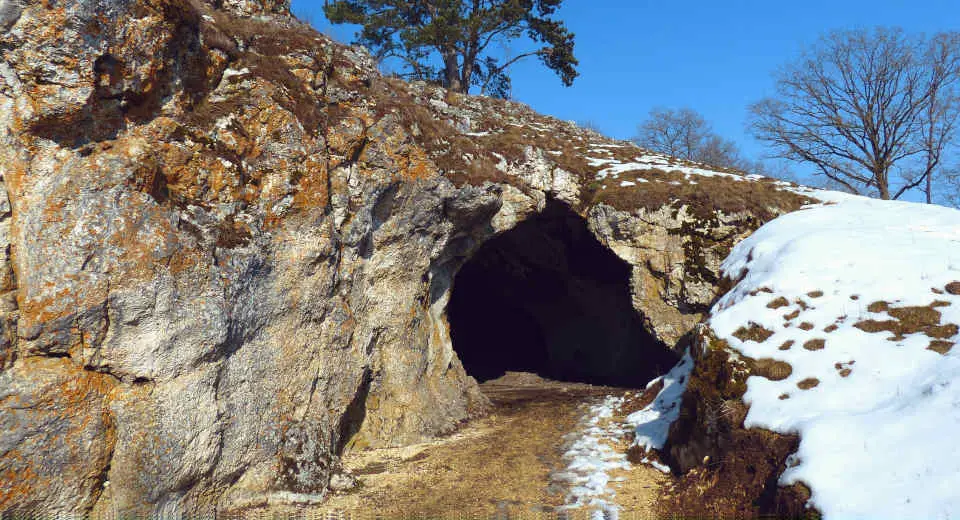
One of the oldest works of art in the world was discovered in the Vogelherd Cave in 1931: the Vogelherd figurines from the Aurignacian period. The ivory carvings, which are over 32,000 years old, are artefacts of Stone Age hunters and depict wild horses, mammoths, bears, bison and cave lions. They are the first animal sculptures created by humans and are among the oldest works of art known to mankind!
The Vogelherdhöhle is one of the six UNESCO World Heritage Caves and is located near Niederstrotzingen in the Lon Valley between Ulm and Heidenheim in the Vogelherd Archaeopark in the eastern Swabian Alps. It is a karst cave and is most famous for the Vogelherd figurines. Bones have also been found in the cave, but these are younger and date from the Neolithic period and not from the Upper Palaeolithic period like the small art.
Anyone who wants to refresh their knowledge of prehistory can do so at the themed stations in the archaeopark around the cave. You should definitely visit the visitor centre, where some of the original finds from Vogelherd Cave, such as the mammoth and the cave lion, are on display.
8. Main and County Stud Marbach: Noble Horses from the Orient
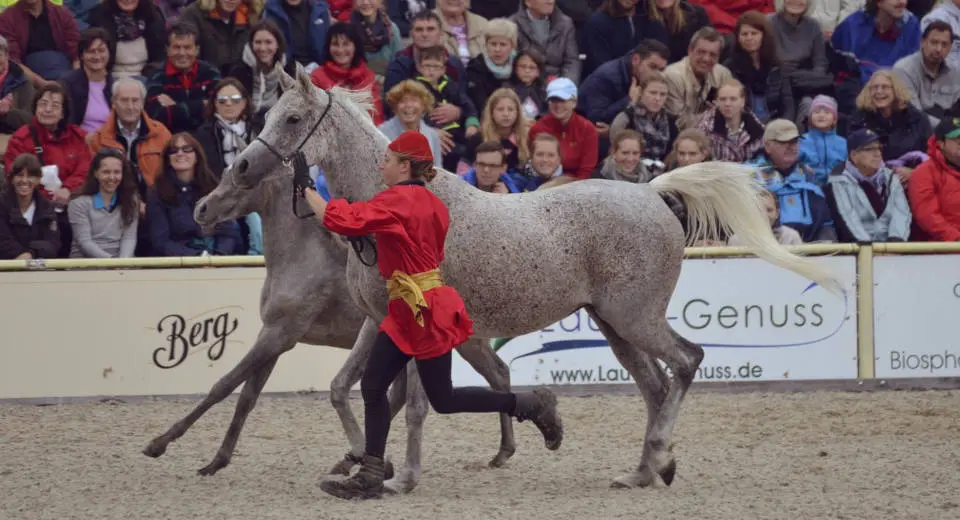
On the back of horses lies the happiness of this earth. 520 to 600 noble horses are standing in Marbach. The stud looks back on more than 500 years of tradition and is one of the first addresses for Arabian horse breeding, which have been bred here since 1816 as the first Arabian purebred outside the Orient. On average, one of the noble stallions costs 26,000 Euros! It is the oldest state stud farm in Germany and is located in the beautiful biosphere reserve near the attractive town of Marbach.
In spring and summer, a walk along the pastures is particularly rewarding: mares with their foals are then in the foal pastures. Throughout the year there are equestrian and horse breeding events and the stud farm is open to visitors all year round.
9. Bizarre Sea of Rocks in the Wental: Stone Witnesses From the Jurassic Period
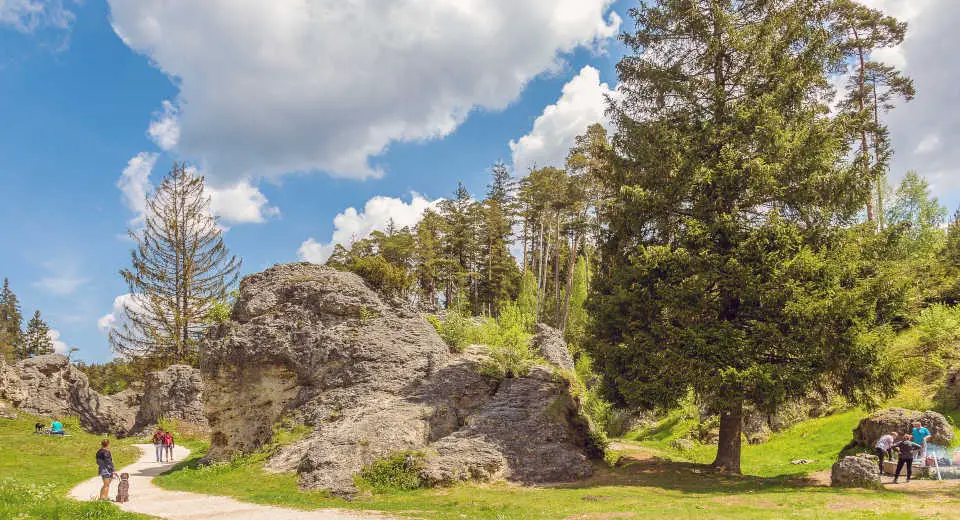
Bizarre rock formations form an impressive sea of rocks on the karst plateau southeast of Bartholomä. The freestanding dolomite rocks bear names such as Hippopotamus, Sphinx, Wentalweible, Spitzbubenstadel or Hirschfelsen and are a magnet not only for children. This special natural landscape was formed from the riverbed of the Wedel, which began to eat its way deeper and deeper into the rock about 150 million years ago in the Jurassic period until it completely seeped away. What remained was the dry valley with its rock formations, which impressively display the power of the water.
Hiking trails lead through the entire Wental, which is almost completely covered by the Felsenmeer. It is a nature reserve with juniper heaths typical of this area and many rare animal and plant species.
10. Blautopf in Blaubeuren – Fairytale Places to Visit at the Swabian Alps
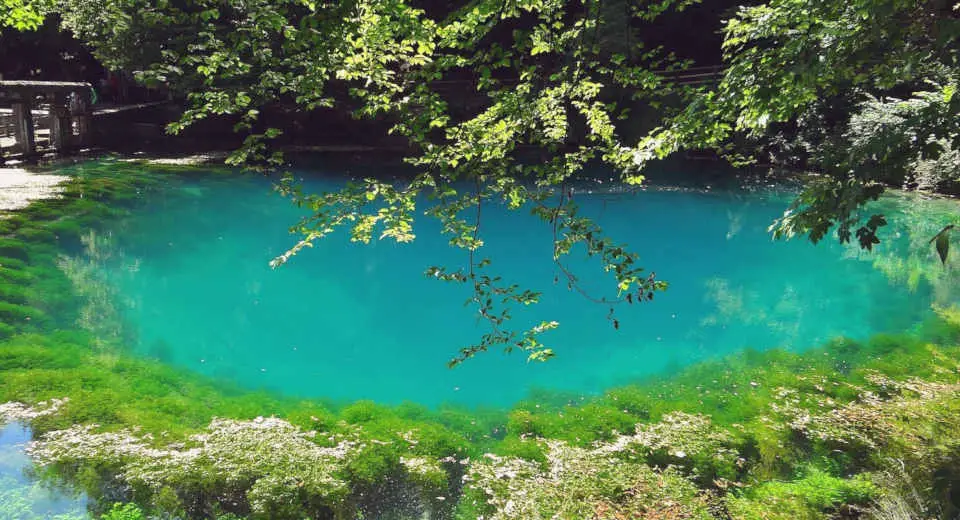
“In Swabia, on the Alb, near the little town of Blaubeuren, close behind the old monk’s monastery, next to an abrupt rock face, one sees the large round cauldron of a wondrous spring called the Blautopf. Towards the morning it sends out a small river, the Blau, which flows into the Danube. This pond is inward like a deep funnel, its water of a colour quite blue, very marvellous, not well to be described in words; but when one draws it, it looks quite bright in the vessel.”
This is how Eduard Mörike begins his story “Die schöne Lau”. It tells how a water mermaid learns to laugh again in this fairytale-like place and is one of the most beautiful fairytales and myths inspired by the Blautopf. As a stone sculpture, the mermaid sits by the water today and many a local may have seen her in the flesh. This place is fabulously beautiful and is one of the most popular excursion destinations in the Swabian Alb. The Blautopf is located in the Blautal valley about 17 kilometres from Ulm on the eastern edge of the Swabian Alb.
The Blautopf gets its blue colour from the fact that the spring water is hardly cloudy and the spring pot is funnel-shaped. This means that it absorbs almost all the colour spectra of the sun’s rays except for the bluish parts. The Blautopf has a diameter of 40 metres and is about 21 metres deep, which means it holds 900 m² of water that turns dark blue in depth. The crystal-clear water reflects the Blaubeuren Monastery, which was founded in 1085 and is well worth seeing. The Blautopf includes a cave system which, with a length of around 10 kilometres, is the largest cave system in the Swabian Alb that has been explored.
Since 1804, a hammer mill has stood directly at the source of the cave and today houses the prehistoric museum. You can go on various hikes around the Blautopf and Blaubeuren itself, with its half-timbered houses and small alleyways, is also worth a visit.
There are many more wonderful places to visit at the Swabian Alps!!! Here I have limited myself to my 10 highlights and put together a colourful mix.
So it is clear that there is no way around Hohenzollern Castle and that some of the other destinations mentioned are also among the popular and well-known excursion destinations in Baden-Württemberg. There are still so many new and unknown things to discover in the wild and romantic Swabian Alb and everywhere in Germany…
On Greatime you will find many tips for excursions and other ideas for activities with friends, activities for two or with the family. True to the motto: There’s no such thing as boredom! 🙂
You don’t want to miss any more excursion tips? Then simply follow us on Facebook, Pinterest and Instagram and subscribe to our Newsletter! 😉
Note: There are affiliate links in this article. This means that if you buy a product, Greatime may receive a small commission.

![10 Must See Places To Visit At The Swabian Alps [Uber En="The*most*beautiful*places*to*visit*at*the*Swabian*Alps" De="Die*schönsten*Ausflugsziele*der*Schwäbischen*Alb"]](https://greatime.de/wp-content/uploads/2021/08/ausflugsziele-schwaebische-alb-zeller-horn.jpg)
![Uber En Quot Panorama Of The City Of Ulm Quot De Quot Panorama Der Stadt Ulm Quot [Uber En="The*most*beautiful*destinations*in*Ulm*-*Panorama*of*the*Old*Town" De="Die*schönsten*Ausflugsziele*in*Ulm*-*Panorama*der*Altstadt"]](https://greatime.de/wp-content/uploads/2022/04/UlmPanorama.jpg)
![Uber En Quot Room Escape Games Quot De Quot Room Escape Games Quot [Uber En="This*is*what*Room*Escape*Games*are*-*they*are*available*in*many*cities" De="Room*Escape*Games*gibt*es*in*vielen*Städten*in*Deutschland"]](https://greatime.de/wp-content/uploads/2017/05/room-escape-games.jpg)
![Uber En Quot Triberg Waterfalls Quot De Quot Triberger Wasserf Lle Quot [Uber En="The*Triberg*Waterfalls*are*the*highest*waterfalls*in*Germany*and*one*of*the*most*famous*places*to*visit*in*the*Black*Forest" De="Die*Triberger*Wasserfälle*sind*die*höchsten*Wasserfälle*in*Deutschland*und*eines*der*bekanntesten*Ausflugsziele*im*Schwarzwald"]](https://greatime.de/wp-content/uploads/2022/08/ausflugsziele-im-schwarzwald-triberg-wasserfaelle.jpg)